There are many species of sea snakes. They vary greatly in color and shape. Their scales distinguish them from eels that have no scales.
Sea snakes occur in salt water along the coasts throughout the Pacific. There are also sea snakes on the east coast of Africa and in the Persian Gulf. There are no sea snakes in the Atlantic Ocean.
There is no need to fear sea snakes. They have not been known to attack a man swimming. Fishermen occasionally get bit by a sea snake caught in a net. The bite is dangerous.
Colubridae
The largest group of snakes worldwide. In this family there are species that are rear-fanged; however, most are completely harmless to man. They have a venom-producing gland and enlarged, grooved rear fangs that allow venom to flow into the wound. The inefficient venom apparatus and the specialized venom is effective on cold-blooded animals (such as frogs and lizards) but not considered a threat to human life. The boomslang and the twig snake of Africa have, however, caused human deaths.
Table 4-3
Viperidae
• Common adder
• Long-nosed adder
• Gaboon viper
• Horned desert viper
• McMahon’s viper
• Mole viper
• Palestinian viper
• Puff adder
• Rhinoceros viper
• Russell’s viper
• Sand viper
• Saw-scaled viper
• Ursini’s viper
Elapidae
• Australian copperhead
• Common cobra
• Coral snake
• Death adder
• Egyptian cobra
• Green mamba
• King cobra
• Krait
• Taipan
• Tiger snake
Crotallidae
• American copperhead
• Boomslang
• Bush viper
• Bushmaster
• Cottonmouth
• Easter diamondback rattlesnake
• Eyelash pit viper
• Fer-de-lance
• Green tre pit viper
• Habu pit viper
• Jumping ciper
• Malayan pit viper
• Mojave rattlesnake
• Pallas’ viper
• Tropical rattlesnake
• Wagler’s pit viper
• Western diamondback rattlesnake
Hydrophilidae
• Banded sea snake
• Yellow-bellied sea snake
LIZARDS
There is little to fear from lizards as long as you follow the same precautions as for avoiding snakebite. Usually, there are only two poisonous lizards: the Gila monster and the Mexican beaded lizard. The venom of both these lizards is neurotoxic. The two lizards are in the same family, and both are slow moving with a docile nature. The komodo dragon (Varanus komodoensis), although not poisonous, can be dangerous due to its large size. These lizards can reach lengths of 3 meters and weigh over 115 kilograms. Do not try to capture this lizard.
POISONOUS SNAKES OF THE AMERICAS
American copperhead
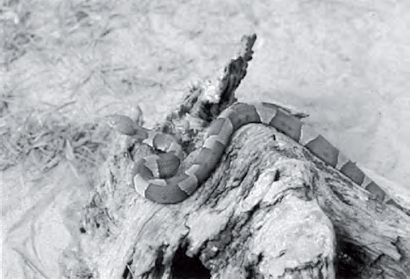
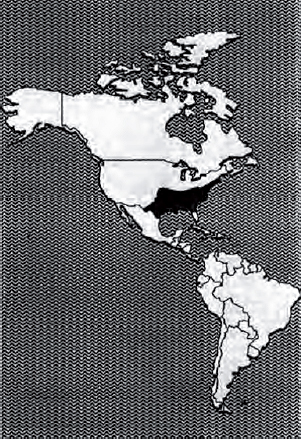
Agkistrodon contortrix
Description: Chestnut color dominates overall, with darker crossbands of rich browns that become narrower on top and widen at the bottom. The top of the head is a coppery color.
Characteristic: Very common over much of its range, with a natural camouflage ability to blend in the environment. Copperheads are rather quiet and inoffensive in disposition but will defend themselves vigorously. Bites occur when the snakes are stepped on or when a victim is lying next to one. A copperhead lying on a bed of dead leaves becomes invisible. Its venom is hemotoxic.
Habitat: Found in wooded and rocky areas and mountainous regions.
Length: Average 60 centimeters, maximum 120 centimeters.
Distribution: Eastern Gulf States, Texas, Arkansas, Maryland, North Florida, Illinois, Oklahoma, Kansas, Ohio, New York, Alabama, Tennessee, and Massachusetts.
Bushmaster
Lachesis mutus
Description: The body hue is rather pale brown or pinkish, with a series of large bold dark brown or black blotches extending along the body. Its scales are extremely rough.
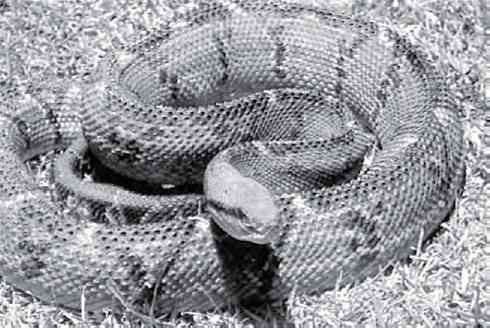
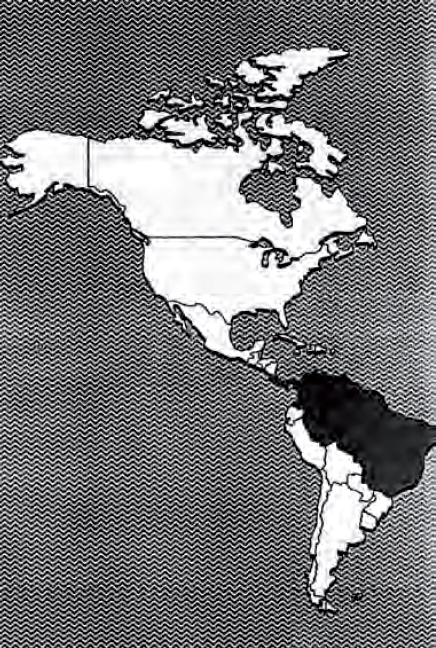

Characteristics: The World’s largest pit viper has a bad reputation. This huge venomous snake is not common anywhere in its range. It lives in remote and isolated habitats and is largely nocturnal in its feeding habits; it seldom bites anyone, so few bites are recorded. A bite from one would indeed be very serious and fatal if medical aid was not immediately available. Usually, the bites occur in remote, dense jungles, many kilometers and several hours or even days away from medical help. Bushmaster fangs are long. In large bushmasters, they can measure 3.8 centimeters. Its venom is a powerful hemotoxin.
Habitat: Found chiefly in tropical forests in their range.
Length: Average 2.1 meters, maximum 3.7 meters.
Distribution: Nicaragua, Costa Rica, Panama, Trinidad, and Brazil.
Coral snake
Micrurus fulvius
Description: Beautifully marked with bright blacks, reds, and yellows. To identify the species, remember that when red touches yellow it is a coral snake.
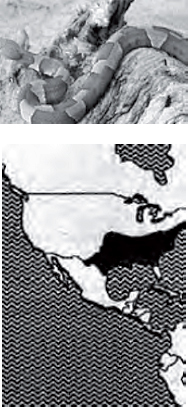
Characteristics: Common over range, but secretive in its habits, therefore seldom seen. It has short fangs that are fixed in an erect position. It often chews to release its venom into a wound. Its venom is very powerful. The venom is neurotoxic, causing respiratory paralysis in the victim, who succumbs to suffocation.
Habitat: Found in a variety of habitats including wooded areas, swamps, palmetto and scrub areas. Coral snakes often venture into residential locations.
Length: Average 60 centimeters, maximum 115 centimeters.
Distribution: Southeast North Carolina, Gulf States, west central Mississippi, Florida, Florida Keys, and west to Texas. Another genus of coral snake is found in Arizona. Coral snakes are also found throughout Central and most South America.
Cottonmouth
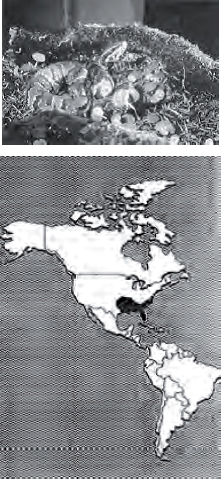
Agkistrodon piscivorus
Description: Colors are variable. Adults are uniformly olive brown or black. The young and subadults are strongly crossbanded with dark brown.
Characteristics: These dangerous semiaquatic snakes closely resemble harmless water snakes that have the same habitat. Therefore, it is best to leave all water snakes alone. Cottonmouths often stand their ground. An aroused cottonmouth will draw its head close to its body and open its mouth showing its white interior. Cottonmouth venom is hemotoxic and potent. Bites are prone to gangrene.
Habitat: Found in swamps, lakes, rivers, and ditches.
Length: Average 90 centimeters, maximum 1.8 meters.
Distribution: Southeast Virginia, west central Alabama, south Georgia, Illinois, east central Kentucky, south central Oklahoma, Texas, North Carolina, South Carolina, Florida, and the Florida Keys.
Eastern diamondback rattlesnake
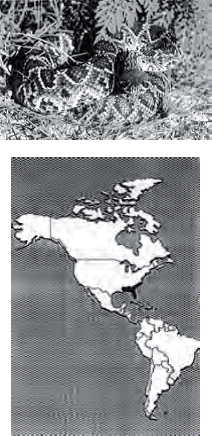
Crotalus adamanteus
Description: Diamonds are dark brown or black, outlined by a row of cream or yellowish scales. Ground color is olive to brown.
Characteristics: The largest venomous snake in the United States. Large individual snakes can have fangs that measure 2.5 centimeters in a straight line. This species has a sullen disposition, ready to defend itself when threatened. Its venom is potent and hemotoxic, causing great pain and damage to tissue.